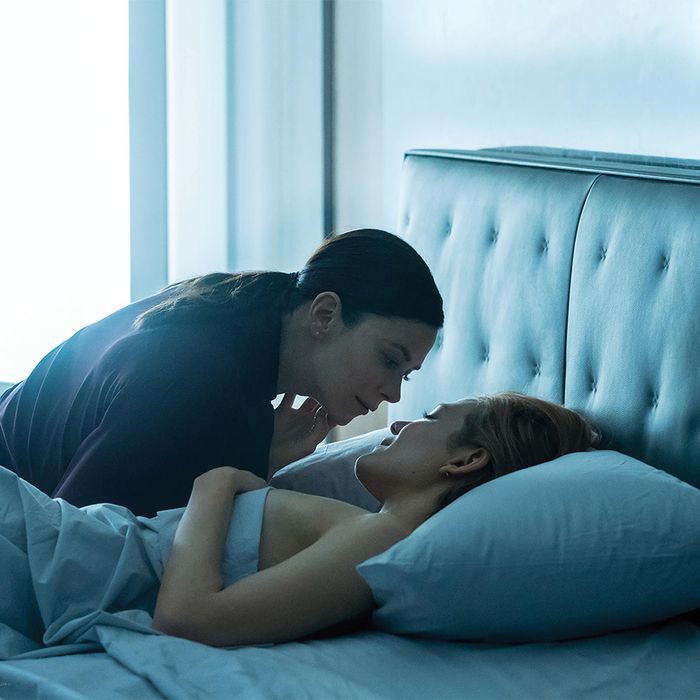https://www.vulture.com/2017/11/the-girlfriend-experience-season-two-review.html
The Girlfriend Experience S2 Pt 1
*******
The Girlfriend Experience’s 2nd Season Is a Mixed Bag
By Matt Zoller Seitz

L-R: Anna Friel and Louisa Krause. Photo: Starz Entertainment, LLC
The first season of Starz’s The Girlfriend Experience was one of the boldest premium-cable projects in years, a half-hour drama with the same title as a film almost nobody saw: a 2009 Steven Soderbergh indie feature about an escort moving through a world of obnoxious finance guys. The TV version had nothing to do with the movie save for the choice of an escort as protagonist. Its first season fused nearly pornographic erotica with aspects of the corporate and legal thriller and the psychological drama; the writing and direction channeled classic 20th-century art-house flicks like Persona and The Passenger. Soderbergh served mainly as a creative matchmaker, pairing two well-regarded indie voices — veteran writer-director Lodge Kerrigan (Clean, Shaven) and actor and short-film maker Amy Seimetz (Stranger Things, The Killing) — then stepping aside. The first season starred Riley Keough as Christine, a law clerk, law student, and secret call girl whose trysts drew her into a corporate conspiracy, publicly humiliated her, and pushed her to question her identity and consider remaking it. Kerrigan and Seimetz co-wrote every episode and took turns directing (Seimetz did six, Kerrigan seven). Although the show’s analytical style could be off-putting, its central performance was mesmerizingly opaque, and its rigor was fascinating. Season one was a rare TV drama that revealed psychology through action, be it as visually spectacular as a prolonged sex scene or as mundane as Christine nervously setting down a drink after being warned by a client’s wife never to go near him again. The finale, which unfolded like a compact one-act play, detailed just one of Christine’s appointments with a john obsessed with a cuckold fantasy; it was filled with images and lines that served as a commentary on the acts of storytelling, filmmaking, and performance, including discussions of word choice and intonation during sex talk and a shot of the client opening motorized window blinds that was framed to evoke curtains rising on a stage production.
Season two is an experiment of a different kind. The winning team has split up. Kerrigan and Seimetz have each written their own half-hour, seven-episode series that are being presented as concurrent but separate events. Successive installments are paired on the same night over seven weeks. But whether this arrangement was meant to spark associations between the narratives or simply confirm that the filmmakers were creative equals who’ve been given their own sandboxes to play in, it doesn’t add much to the viewing experience, because the projects are so different in subject matter, visual style, tone, and worldview.
Kerrigan’s “Erica & Anna” is half–psychological drama, half–political thriller, set in Washington, D.C. (actually Toronto). The city streets and eerily unfurnished interiors are photographed with ruthless compositional exactness and populated by cruel and/or desperately unhappy people. The main characters are Anna (Louisa Krause), an escort who caters to political types, and Erica (Anna Friel), a high-powered operative who funds races through a super-pac. The two become entangled when Erica convinces Anna to help her in a blackmail scheme. Then Anna and Erica fall in love, and the story becomes a tale of sexual and emotional obsession. Kerrigan’s script alternates edgy discussions of the main characters’ relationships with graphic sex scenes (between Erica and Anna and Anna and her clients) and scenes where Anna tries to navigate a complicated congressional race in which obscene amounts of money and power are at stake.
Unfortunately, Kerrigan never convinces us that the carnal aspects of the series are integral to the exploration of Anna and Erica’s psychologies. You can skip at least half of the sex scenes and not lose important plot information — a marked contrast to the original The Girlfriend Experience. Neither these nor the intense scenes of Erica and Anna flirting, fighting, and breaking down in cathartic tears ever fully connect with the stuff about money, politics, and money-in-politics. Despite fully committed and often superb performances, neither Erica nor Anna come alive as recognizable human beings. The same is true of the men, most of whom are morally hideous Ayn Randian right-wingers gassing about the glories of job creation and the ingratitude of the undeserving poor. It’s clear that Kerrigan was going for something other than naturalism here, and that the series’s misanthropic vision of American life (which would be misogynistic if the director didn’t seem to hold the men in greater contempt) is integral to whatever he’s doing. But despite powerful individual scenes and sequences, the series’s larger vision never snaps into focus....
No comments:
Post a Comment